非谓语动词之动词不定式(todo)的用法
- 格式:pdf
- 大小:20.01 KB
- 文档页数:3
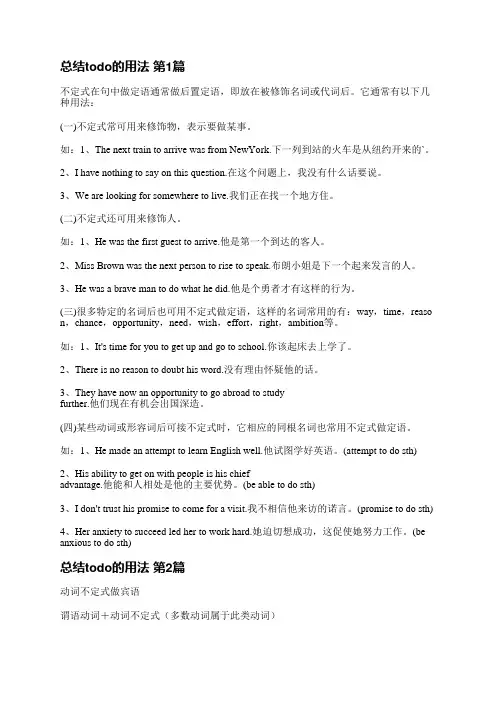
总结todo的用法第1篇不定式在句中做定语通常做后置定语,即放在被修饰名词或代词后。
它通常有以下几种用法:(一)不定式常可用来修饰物,表示要做某事。
如:1、The next train to arrive was from NewYork.下一列到站的火车是从纽约开来的`。
2、I have nothing to say on this question.在这个问题上,我没有什么话要说。
3、We are looking for somewhere to live.我们正在找一个地方住。
(二)不定式还可用来修饰人。
如:1、He was the first guest to arrive.他是第一个到达的客人。
2、Miss Brown was the next person to rise to speak.布朗小姐是下一个起来发言的人。
3、He was a brave man to do what he did.他是个勇者才有这样的行为。
(三)很多特定的名词后也可用不定式做定语,这样的名词常用的有:way,time,reaso n,chance,opportunity,need,wish,effort,right,ambition等。
如:1、It's time for you to get up and go to school.你该起床去上学了。
2、There is no reason to doubt his word.没有理由怀疑他的话。
3、They have now an opportunity to go abroad to studyfurther.他们现在有机会出国深造。
(四)某些动词或形容词后可接不定式时,它相应的同根名词也常用不定式做定语。
如:1、He made an attempt to learn English well.他试图学好英语。
(attempt to do sth) 2、His ability to get on with people is his chiefadvantage.他能和人相处是他的主要优势。
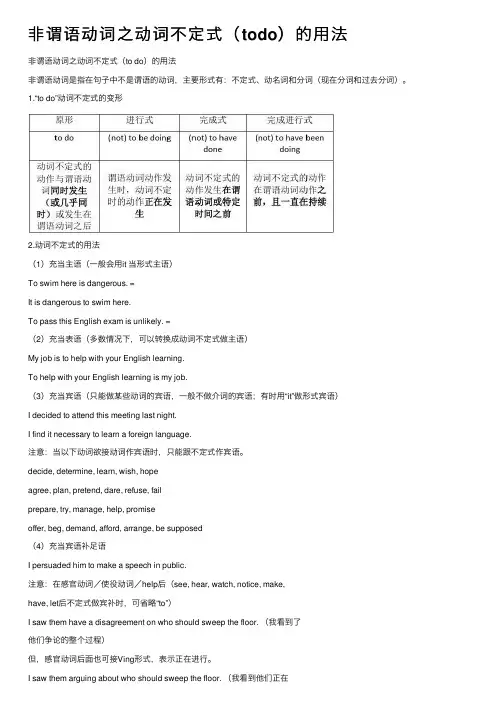
⾮谓语动词之动词不定式(todo)的⽤法⾮谓语动词之动词不定式(to do)的⽤法⾮谓语动词是指在句⼦中不是谓语的动词,主要形式有:不定式、动名词和分词(现在分词和过去分词)。
1.“to do”动词不定式的变形2.动词不定式的⽤法(1)充当主语(⼀般会⽤it 当形式主语)To swim here is dangerous. =It is dangerous to swim here.To pass this English exam is unlikely. =(2)充当表语(多数情况下,可以转换成动词不定式做主语)My job is to help with your English learning.To help with your English learning is my job.(3)充当宾语(只能做某些动词的宾语,⼀般不做介词的宾语;有时⽤“it”做形式宾语)I decided to attend this meeting last night.I find it necessary to learn a foreign language.注意:当以下动词欲接动词作宾语时,只能跟不定式作宾语。
decide, determine, learn, wish, hopeagree, plan, pretend, dare, refuse, failprepare, try, manage, help, promiseoffer, beg, demand, afford, arrange, be supposed(4)充当宾语补⾜语I persuaded him to make a speech in public.注意:在感官动词/使役动词/help后(see, hear, watch, notice, make,have, let后不定式做宾补时,可省略“to”)I saw them have a disagreement on who should sweep the floor. (我看到了他们争论的整个过程)但,感官动词后⾯也可接Ving形式,表⽰正在进⾏。
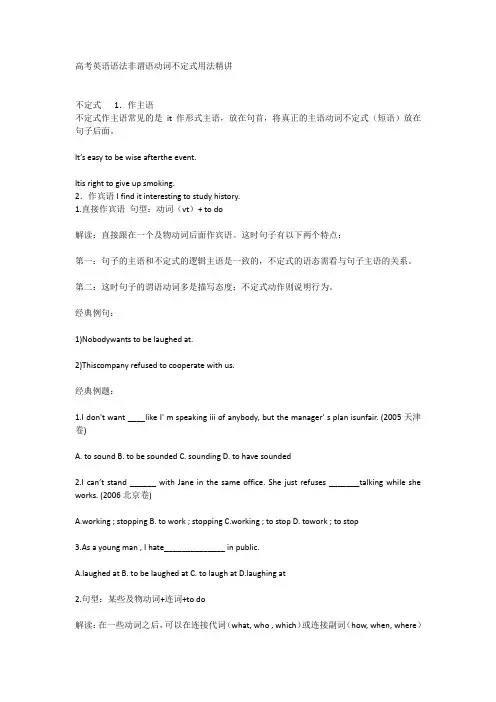
高考英语语法非谓语动词不定式用法精讲不定式1.作主语不定式作主语常见的是it 作形式主语,放在句首,将真正的主语动词不定式(短语)放在句子后面。
It’s easy to be wise afterthe event.Itis right to give up smoking.2.作宾语I find it interesting to study history.1.直接作宾语句型:动词(vt)+ to do解读:直接跟在一个及物动词后面作宾语。
这时句子有以下两个特点:第一:句子的主语和不定式的逻辑主语是一致的,不定式的语态需看与句子主语的关系。
第二:这时句子的谓语动词多是描写态度;不定式动作则说明行为。
经典例句:1)Nobodywants to be laughed at.2)Thiscompany refused to cooperate with us.经典例题:1.I don't want ____like I' m speaking iii of anybody, but the manager' s plan isunfair. (2005天津卷)A. to soundB. to be soundedC. soundingD. to have sounded2.I can’t stand ______ with Jane in the same office. She just refuses _______talking while she works. (2006北京卷)A.working ; stoppingB. to work ; stoppingC.working ; to stopD. towork ; to stop3.As a young man , I hate______________ in public.ughed atB. to be laughed atC. to laugh atughing at2.句型:某些及物动词+连词+to do解读:在一些动词之后,可以在连接代词(what, who , which)或连接副词(how, when, where)及连词whether 后面接一个带to 的动词不定式作宾语。
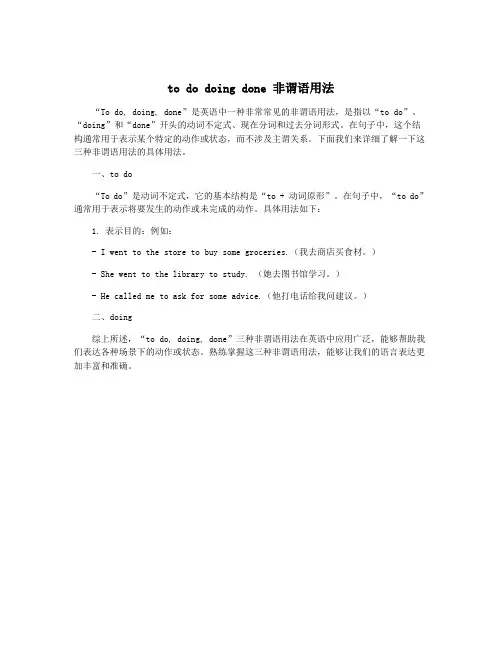
to do doing done 非谓语用法
“To do, doing, done”是英语中一种非常常见的非谓语用法,是指以“to do”、“doing”和“done”开头的动词不定式、现在分词和过去分词形式。
在句子中,这个结构通常用于表示某个特定的动作或状态,而不涉及主谓关系。
下面我们来详细了解一下这三种非谓语用法的具体用法。
一、to do
“To do”是动词不定式,它的基本结构是“to + 动词原形”。
在句子中,“to do”通常用于表示将要发生的动作或未完成的动作。
具体用法如下:
1. 表示目的:例如:
- I went to the store to buy some groceries.(我去商店买食材。
)
- She went to the library to study. (她去图书馆学习。
)
- He called me to ask for some advice.(他打电话给我问建议。
)
二、doing
综上所述,“to do, doing, done”三种非谓语用法在英语中应用广泛,能够帮助我们表达各种场景下的动作或状态。
熟练掌握这三种非谓语用法,能够让我们的语言表达更加丰富和准确。

英语中不定式(todo)的6种成分和2种独立用法非谓语是英语学习的重点也是难点,很多同学对这个语法知识一直是处于比较懵的状态。
其实只要掌握非谓语所充当成分的用法就可以运用自如了。
非谓语,顾名思义就是不做谓语的动词的变化形式,即to do ,doing,done。
除了谓语,句子成分中还有主语、宾语、表语、宾语补足语、定语和状语。
下面看看不定式(to do)充当这6种成分的用法:一、不定式作主语1.To see is to believe. (这种情况不常用)2. It is important to learn English well.It 是形式主语,真正的主语是 to learn English well. 这种用法是常用的而且是考点!考点!考点!二、不定式作表语:常说明主语的内容、性质和特征或表动作将要发生。
1. My job is to keep the children safe.2.My task is to type the article.三、不定式做宾语1.He prefers to eat white bread and rice.2.He wants to play football.3.动词feel, find, make, think等后面,可以用it作形式宾语代替真正的宾语——动词不定式,句子结构是...feel / find / make / ... it+adj. / n.+to do...。
如:I find it difficult to remember everything.常接动词不定式作宾语的动词有:(需要记住)agree, afford, appear, ask, attempt;care, choose, claim;dare,decide,demand,deserve,determine;expect, fail, get, guarantee;hate, hesitate, hope, hurry;intend, learn, manage, offer,plan, prepare, pretend, promise;refuse, seem, tend, threaten;want, wish 等四、不定式做宾语补足语1.I'd invite her to have dinner at my house.2 . We should allow the children to choose their own clothes.Note 1: 带to的动词不定式作宾语补足语的动词主要有:要求允许提议(ask, allow, advise),期望邀请鼓励(expect, invite, encourage),教导告诉想要(teach, tell, want),等待希望愿意(wait for, wish, would like / love)。
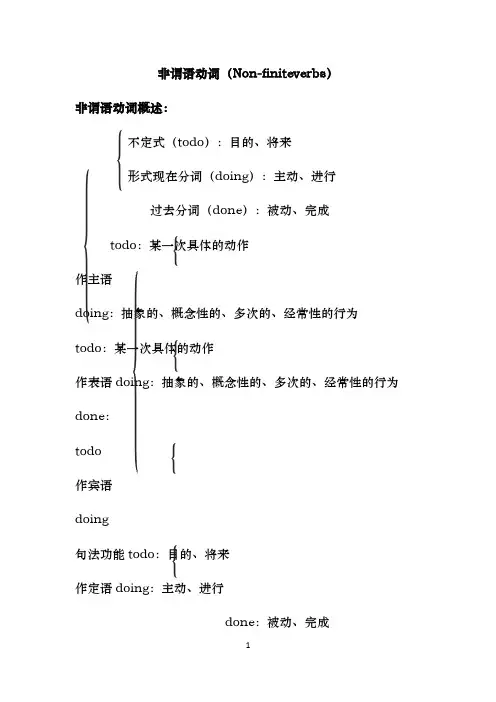
非谓语动词(Non-finiteverbs)非谓语动词概述:不定式(todo):目的、将来形式现在分词(doing):主动、进行过去分词(done):被动、完成todo:某一次具体的动作作主语doing:抽象的、概念性的、多次的、经常性的行为todo:某一次具体的动作作表语doing:抽象的、概念性的、多次的、经常性的行为done:todo作宾语doing句法功能todo:目的、将来作定语doing:主动、进行done:被动、完成todo:目的、将来作宾补doing:主动、进行done:被动、完成todo:目的、将来作状语doing:主动、进行done:被动、完成独立成分作状语n./pron.+todo/doing/done独立主格结构with的复合结构GrammarI:非谓语动词的形式(一)过去分词:过去分词只有一种形式,就是一般式done。
①单独表示一个被动的动作;②也可以单独表示动作已经完成;③还可以同时表示被动和完成。
(二)现在分词的各种形式:(三)主动被动用法一般doing beingdone doing的动作与谓语动作几e.g.1._______________(hear)thenews,theycouldn’thelpla ughing.e.g.2.Not________________(finish)thetask,theyhavetostayt hereforanothertwoweeks.e.g.3.________________(turn)offtheTVset,hebegantogoover (复习)hislessons.e.g.4.______________(heat加热),thewatergetshot.e.g.5._______________(build)forhalfayear,thebuildingbeca meourlibrary.e.g.6._______________(tell)manytimes,hestillrepeated(重复)thesamemistake.e.g.7.Isawtherewasaboy________________(blame)byhisfat her.(四)不定式的各种形式(五)e.g.1.Therearemanydishes_________________(wash)inthek itchen.SoIdon’thavetimetoseeafilmwithyoutonight.注意:非谓语动词的否定形式是在其前加notGrammarII:todo、doing作主语或表语一、todo、doing作主语的一般用法:e.g.1.Toswimtodayisagoodideae.g.2.Eatingtoomuchisbad foryourhealth.思考:todo作主语,表__________________________________________________的动作;doing作主语,表_________________________________________________的动作。
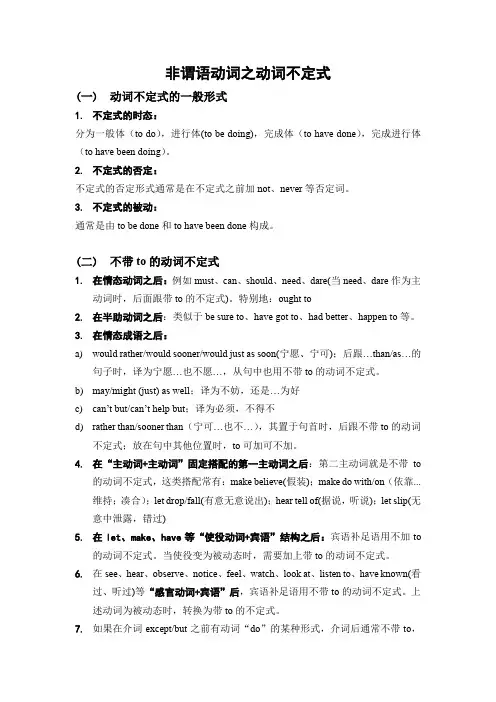
非谓语动词之动词不定式(一)动词不定式的一般形式1.不定式的时态:分为一般体(to do),进行体(to be doing),完成体(to have done),完成进行体(to have been doing)。
2.不定式的否定:不定式的否定形式通常是在不定式之前加not、never等否定词。
3.不定式的被动:通常是由to be done和to have been done构成。
(二)不带to的动词不定式1.在情态动词之后:例如must、can、should、need、dare(当need、dare作为主动词时,后面跟带to的不定式)。
特别地:ought to2.在半助动词之后:类似于be sure to、have got to、had better、happen to等。
3.在情态成语之后:a)would rather/would sooner/would just as soon(宁愿、宁可);后跟…than/as…的句子时,译为宁愿…也不愿…,从句中也用不带to的动词不定式。
b)may/might (just) as well;译为不妨,还是…为好c)can’t but/can’t help but;译为必须,不得不d)rather than/sooner than(宁可…也不…),其置于句首时,后跟不带to的动词不定式;放在句中其他位置时,to可加可不加。
4.在“主动词+主动词”固定搭配的第一主动词之后:第二主动词就是不带to的动词不定式,这类搭配常有:make believe(假装);make do with/on(依靠...维持;凑合);let drop/fall(有意无意说出);hear tell of(据说,听说);let slip(无意中泄露,错过)5.在let、make、have等“使役动词+宾语”结构之后:宾语补足语用不加to的动词不定式。
当使役变为被动态时,需要加上带to的动词不定式。
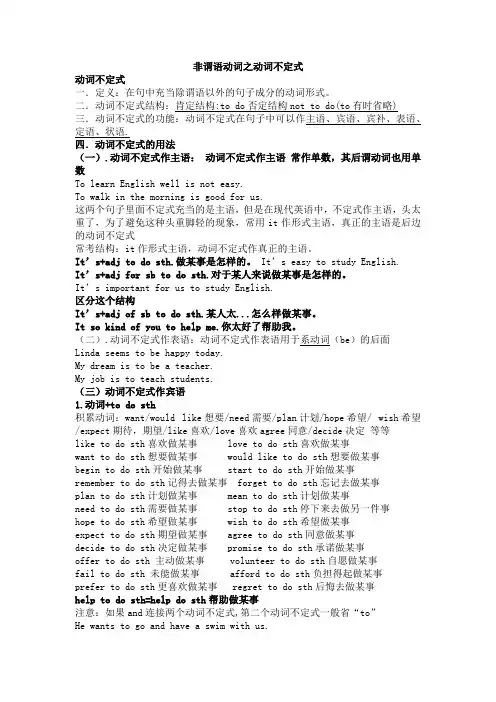
非谓语动词之动词不定式动词不定式一.定义:在句中充当除谓语以外的句子成分的动词形式。
二.动词不定式结构:肯定结构:to do否定结构not to do(to有时省略) 三.动词不定式的功能:动词不定式在句子中可以作主语、宾语、宾补、表语、定语、状语.四.动词不定式的用法(一).动词不定式作主语:动词不定式作主语常作单数,其后谓动词也用单数To learn English well is not easy.To walk in the morning is good for us.这两个句子里面不定式充当的是主语,但是在现代英语中,不定式作主语,头太重了,为了避免这种头重脚轻的现象,常用it作形式主语,真正的主语是后边的动词不定式常考结构:it作形式主语,动词不定式作真正的主语。
It’s+adj to do sth.做某事是怎样的。
It’s easy to study English.It’s+adj for sb to do sth.对于某人来说做某事是怎样的。
It’s important for us to study English.区分这个结构It’s+adj of sb to do sth.某人太...怎么样做某事。
It so kind of you to help me.你太好了帮助我。
(二).动词不定式作表语:动词不定式作表语用于系动词(be)的后面Linda seems to be happy today.My dream is to be a teacher.My job is to teach students.(三)动词不定式作宾语1.动词+to do sth积累动词:want/would like想要/need需要/plan计划/hope希望/ wish希望/expect期待,期望/like喜欢/love喜欢agree同意/decide决定等等like to do sth喜欢做某事 love to do sth喜欢做某事want to do sth想要做某事 would like to do sth想要做某事begin to do sth开始做某事 start to do sth开始做某事remember to do sth记得去做某事 forget to do sth忘记去做某事plan to do sth计划做某事 mean to do sth计划做某事need to do sth需要做某事 stop to do sth停下来去做另一件事hope to do sth希望做某事 wish to do sth希望做某事expect to do sth期望做某事 agree to do sth同意做某事decide to do sth决定做某事 promise to do sth承诺做某事offer to do sth 主动做某事 volunteer to do sth自愿做某事fail to do sth 未能做某事 afford to do sth负担得起做某事prefer to do sth更喜欢做某事 regret to do sth后悔去做某事help to do sth=help do sth帮助做某事注意:如果and连接两个动词不定式,第二个动词不定式一般省“to”He wants to go and have a swim with us.他想和我们一起去游泳.2.若作宾语的动词不定式很长,可用it作形式宾语. 动词+it+adj(for sb)to do sth make/find/think +it+adj(for sb)to do sthI find it interesting to learn English with you.我觉得和你一起学英语很有趣.He found it hard to catch up with others.他觉得赶上别人很困难.(四)动词不定式作宾语补足语放在宾语后,有三种情况1.动词+sb to do sth.积累动词:want/would like想要/allow允许/ask询问/wish希望/expect期待,期望/tell告诉order命令/advise建议等等want sb to do sth 想要某人做某事would like sb to do sth想要某人做某事allow sb to do sth允许某人做某事ask sb to do sth要求某人做某事request sb to sth要求某人做某事require sb to do sth要求某人做某事wish sb to do sth希望某人做某事expect sb to do sth期望某人做某事tell sb to do sth告诉某人做某事teach sb to do sth教某人做某事order sb to do sth命令某人做某事advise sb to do sth建议某人做某事invite sb to do sth邀请某人做某事encourage sb to do sth鼓励某人做某事2.跟不带to的的不定式作宾补:动词+sb+ do sth使役动词和感官动词let sb do sth 让某人做某事 have sb do sth 让某人做某事make sb do sth 让某人做某事 see sb do sth 看见某人做某事watch sb do sth看见某人做某事 hear sb do sth听见某人做某事notice sb do sth 注意某人做某事 feel sb do sth感觉某人做某事3.可跟to或不跟to的不定式作宾补help sb do sth帮助某人做某事help sb to do sth帮助某人做某事(五).动词不定式作定语:动词不定式作定语常用来修饰名词或不定代词,放于所修饰的词后,为后置定语I have some work to do.我有一些要做的工作。
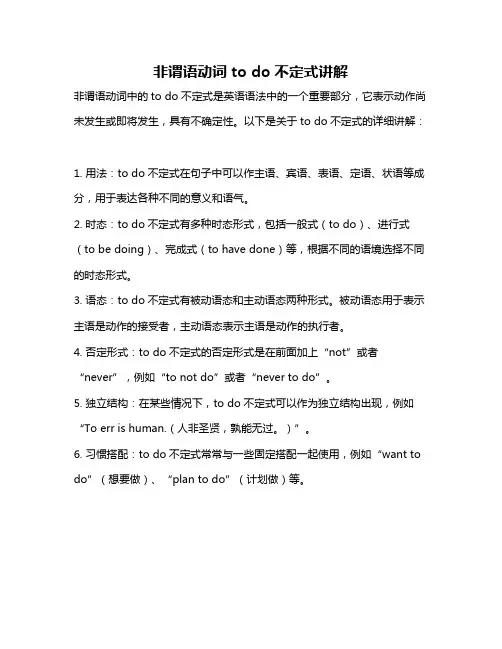
非谓语动词to do不定式讲解
非谓语动词中的to do不定式是英语语法中的一个重要部分,它表示动作尚未发生或即将发生,具有不确定性。
以下是关于to do不定式的详细讲解:
1. 用法:to do不定式在句子中可以作主语、宾语、表语、定语、状语等成分,用于表达各种不同的意义和语气。
2. 时态:to do不定式有多种时态形式,包括一般式(to do)、进行式(to be doing)、完成式(to have done)等,根据不同的语境选择不同的时态形式。
3. 语态:to do不定式有被动语态和主动语态两种形式。
被动语态用于表示主语是动作的接受者,主动语态表示主语是动作的执行者。
4. 否定形式:to do不定式的否定形式是在前面加上“not”或者“never”,例如“to not do”或者“never to do”。
5. 独立结构:在某些情况下,to do不定式可以作为独立结构出现,例如“To err is human.(人非圣贤,孰能无过。
)”。
6. 习惯搭配:to do不定式常常与一些固定搭配一起使用,例如“want to do”(想要做)、“plan to do”(计划做)等。
总之,to do不定式是一个非常灵活的非谓语动词形式,在不同的语境中有不同的用法和意义。
通过掌握其基本用法和规则,能够更好地理解和运用这种语言现象,提高英语表达能力。
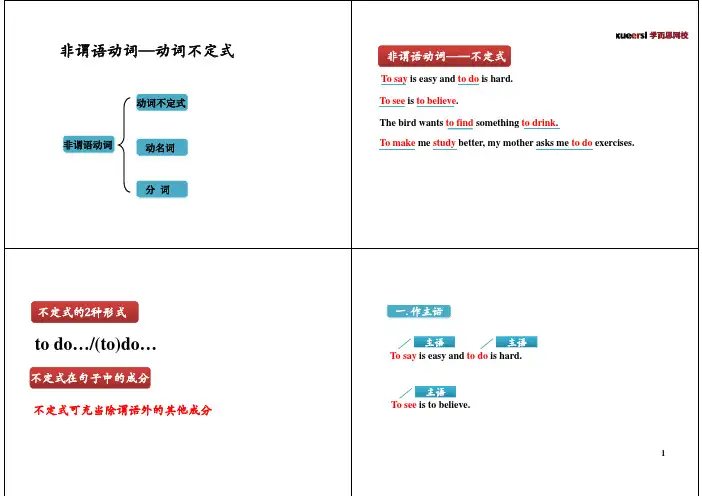
非谓语动词不定式非谓语动词——不定式不定式的2种形式不定式在句子中的成分say is easy and is hard.主语主语To say is easy and is hard.To see is to believe.主语’s +adj. for sb. to do sth.形式主语真正主语该类形容词有:difficult/hard/important/possible/adj. 修饰sth. j dj f b h 形式主语真正主语impossible/comfortable/necessary 等该类形容词有:adj. 修饰sb.’s +adj. of sb. to do sth.类形容有kind/nice/stupid/rude/clever/foolish/thoughtful/brave/considerate 等It ’s interesting It ’s kind of you to help To see is to believe 表语To see is to believe .对于一个老师来说最重要的事The most important thing for a 是公平地对待每个学生.The most important thing for a teacher is to treat every student equally.三. 作宾语The bird wants to find something to drink.宾语+不定式作宾语的动词有:三个希望两答应:hope, wish, want, agree, promise 两个要求未拒绝:设法学会做决定:不需假装在选择p ,,,g ,p demand, ask, fail, refuse manage, intend, learn, decide, determine 不需假装在选择:desire, pretend, choose But the bird found it hard to find water.主语+find/think +it + adj. + to do sth.形式宾语真正宾语j 宾补asks me to do exercises.主谓关系advise, allow, ask, wish ll h want, get, order, tell, teachTo make me study better, my mother asks me to do exercises.make me study (省略to 的)宾补的宾补的动词有:,y y listen to, hear)let,have)make, let, have) see, notice, observe, watch)注意:五. 作定语作定语The bird wants to find something to drink 定语The bird wants to find something to drink .I want to find a comfortable pillow to lie on.d b 目的状语To make me study better , my mother exercises.The cat is too control itself 结果状语The cat is too excitedto control itself .---Lucy had a bad cold. ---I am sorry to hear that.原因状语o e .to leave didn’t tell his 宾语when to leave and t tell his how to improve their products.宾语The man lost his way, so he didn’t know where to go.。
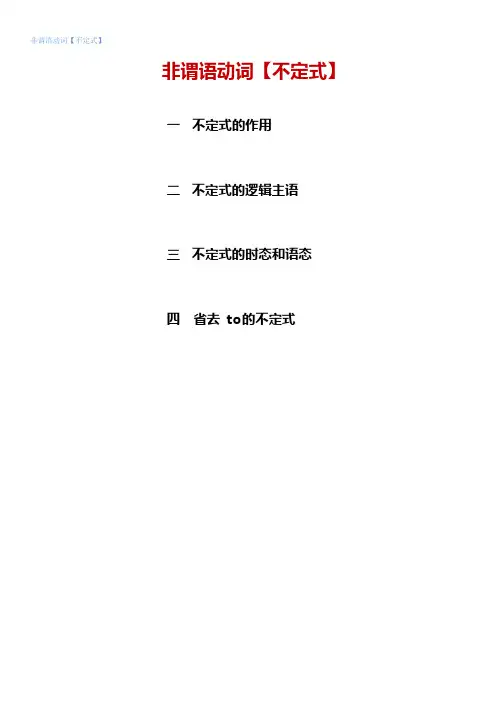
非谓语动词【不定式】非谓语动词【不定式】一不定式的作用二不定式的逻辑主语三不定式的时态和语态四省去to 的不定式三种非谓语动词形式,即不定式(to do)、动名词(doing)、分词(现在分词d oing &过去分词done)一不定式的作用1. 作主语(It + to do)不定式作句子主语的情况非常常见,通常有两种结构:(1)不定式t o do 直接放在句首的主语位置例:To l ove f or t he s ake o f b eing l oved i s h uman,but t o l ove f or t he s ake o f l oving i s a ngelic.因为被爱而爱,是人之常情;因为爱而爱,则难能可贵。
(2)不定式t o do 放在句末,而用i t 作形式主语指代句末的不定式这种情况下,又有不同结构,如①“It is +形容词+ to do”结构(此处的形式主语不能用t his 或t hat 来替换)Itis possible to give without loving,but it is impossible to love without giving.我们可以付出而不爱,但不可能爱而不付出。
②其他结构,如It takes time and efforts to master English.It is my duty to help you with English.2. 做宾语(动词+ to do)不定式作句子宾语,通常有三种可能的结构:(1)动词+ to do(句子主语和不定式逻辑主语一致)Ihope to see you again.(2)动词+疑问词+ t o d o在一些动词后,可以在连接代词(what ,which,who)或连接副词(how,when,where)及连词whether 后面接一个带t o 的不定式,可将该结构看成是连接词引导的宾语从句的简略形式。
浅谈动词不定式的用法动词不定式是动词的一种非谓语形式,即:to+动词原形。
动词不定式(短语)有名词、形容词和副词的作用,在句子中除了不能作谓语外,几乎可以作其它任何成分。
1.作主语。
如:TolearnEnglishisveryuseful.学英语非常有用。
此类句子常用形式主语“it”来代替真正的主语,如:It′sveryusefultolearnEnglish.2.作宾语。
如:Iwanttoplaybasketball.我想打篮球。
3.作宾语补足语。
如:Ourteacherasksustoanswerthequestion.我们的老师让我们回答问题。
4.作表语。
如:(1)Herworkistolookafterthechildren.她的工作是看孩子。
(2)Themostimportantthingistofinishthework.最重要的事情是完成这项工作。
5.作定语。
(1)被修饰成分在意义上是动词不定式所表示动作的执行者时,作定语用的动词不定式的动词应是不及物动词,如果是及物动词,动词要带宾语。
如:①Ourteacherisalwayst hefirstonetocometoourclassroomandthelastonetolea ve.我们的老师总是第一个来教室,最后一个离开。
②Isawtheforeignerrideabike.我看见一位骑自行车的外国人。
(2)被修饰成分在意义上是动词不定式所表示动作的承受者时,作定语用的动词不定式的动词应是及物动词,如果是不及物动词,其后必须加相应的介词。
如:Theboyhasnopenciltowritewith.这个男孩没有写的铅笔。
(3)被修饰成分在意义上既不是动词不定式所表示动作的执行者,也不是动词不定式所表示动作的承受者时,作定语用的动词不定式(短语)比较灵活,既可以是不及物动词,也可以是及物动词加宾语构成的动词短语。
如:①There´snotimetoplaygames.没有做游戏的时间。
非谓语动词不定式(to do)的用法小结I.不定式的语法意义1.不定式具有名词、形容词、副词的特征,在句中可作主、宾、定、表、补和状语。
2.没有人称和数的变化,在句子中不能作谓语,但有时态和语态的变化。
3.仍保留动词的特征,即可有自己的宾语和状语,和他们一起构成不定式短语。
II. 不定式的否定式not to doIII.不定式的时态和语态1.一般式(to do/to be done)表示动作或状态与谓语动词的动作或状态同时发生或发生在其后。
2.完成式(to have done/to have been done)表示动作或状态在谓语动词的动作或状态之前。
3.进行式(to be doing)表示动作谓语动词所表示的动作或状态发生时正在发生。
4.完成进行式(to have been doing)表示在谓语动词的动作或状态发生之前开始进行的行为,到谓语动作发生时,可能停止,也可能会持续下去。
IV.不定式的功能1.作主语:(1)to do可直接作主语,表示特指一个具体动作。
eg.To swim in that river is very dangerous.To study English well isn’teasy.(2) 用it作为形式主语,而把真正的不定式主语放到句中。
常见的有6种。
It is +adj+ to do sth.eg.It is nice not to be dependent onothers.It is +adj+for sb to do sth.eg.It is not hard for one to do a bit of goodIt is +adj+of sb to do sth.eg. It is silly of you to believe him.= You are silly to believe him.It is +noun+to do sth.eg.It was not his habit to ask people for things.It+动词(+宾语)+ to do sth.eg.It took me a year to finish writing thebook.It is+介词短语+to do sth.eg.It is beyond my power to answer this question.2.作表语:to do作表语很普遍,多数情况下可换作主语eg.Her job is to teach us maths.To teach us maths is her job.3.作宾语:to do作宾语直接跟在vt 动词后面。
非谓语动词不定式(to do)的用法小结I.不定式的语法意义1.不定式具有名词、形容词、副词的特征,在句中可作主、宾、定、表、补和状语。
2.没有人称和数的变化,在句子中不能作谓语,但有时态和语态的变化。
3.仍保留动词的特征,即可有自己的宾语和状语,和他们一起构成不定式短语。
II. 不定式的否定式not to doIII.不定式的时态和语态1.一般式(to do/to be done)表示动作或状态与谓语动词的动作或状态同时发生或发生在其后。
2.完成式(to have done/to have been done)表示动作或状态在谓语动词的动作或状态之前。
3.进行式(to be doing)表示动作谓语动词所表示的动作或状态发生时正在发生。
4.完成进行式(to have been doing)表示在谓语动词的动作或状态发生之前开始进行的行为,到谓语动作发生时,可能停止,也可能会持续下去。
IV.不定式的功能1.作主语:(1)to do可直接作主语,表示特指一个具体动作。
eg.To swim in that river is very dangerous.To study English well isn’teasy.(2) 用it作为形式主语,而把真正的不定式主语放到句中。
常见的有6种。
It is +adj+ to do sth.eg.It is nice not to be dependent onothers.It is +adj+for sb to do sth.eg.It is not hard for one to do a bit of goodIt is +adj+of sb to do sth.eg. It is silly of you to believe him.= You are silly to believe him.It is +noun+to do sth.eg.It was not his habit to ask people for things.It+动词(+宾语)+ to do sth.eg.It took me a year to finish writing thebook.It is+介词短语+to do sth.eg.It is beyond my power to answer this question.2.作表语:to do作表语很普遍,多数情况下可换作主语eg.Her job is to teach us maths.To teach us maths is her job.3.作宾语:to do作宾语直接跟在vt 动词后面。
The room was quite dark inside, so he made some candles to give light.(candles做了to give light的动作,是不定式的逻辑主语)注意:1)如果不定式所修饰的名词是time, place或way,不定式后面习惯上要省略介词。
He had no money and no place to live.2)不定式所修饰的名词或代词是不定式动作的承受者时,不定式既可用主动语态,又可用被动语态,但含义不同。
如果修饰名词的不定式的动作是主语做的, 不定式用主动语态。
试比较:•Have you anything to send?•Have you anything to be sent?3)不定式作定语多表示将来,而动词-ing形式表示正在进行或用途,过去分词则表示已经完成和被动。
a problem to be discussed tomorrow 明天要讨论的问题a problem being discussed now 现在正讨论的问题a problem discussed for thousands of years 已讨论多年的问题6.作状语A. 作修饰动词的目的状语They ran over to welcome the students.注意:不定式表示目的时前面可以加in order 或so as已示强调。
B. 作修饰动词的结果状语1)不定式作结果状语常表示一种事先没有预料到的情况或结果,放在被修饰动词的后面。
What have I said to make you so angry?2)有时为了进一步加强意料不到的语气,在表示结果的不定式前还可加only。
I went to see him only to find him out.7.动词不定式常用句型:(1) It takes / took / will take sb. some time / money to do sth.某人花/花了/将花多长时间/多少钱做某事. 例句:It took me years of hard work to speak good English.(2) It is + adj +for/of sb to do sth。
动词不定式的语法总结动词不定式是非谓语动词的一种形式,是英语中常见的一种语法,学生一定要做好总结,拿下这个知识点。
小编为大家力荐了动词不定式常用的语法总结,给大家作为参考,欢迎阅读!动词不定式的七种用法动词不定式的基本形式为to+动词原形.1.动词不定式做主语.谓语用第三人称单数形式.如果主语较长则用it做形式主语,将真正的主语动词不定式放到句尾.egTo see is to believe.It's a bad habit to run after dinner.2 做表语.the important things is to save lives.3 做宾语he likes to play with children.4做宾语补足语.形容词做宾补时.常用it做形式宾语.把真正的宾语放到宾补之后.he feels it happy to help others.5做定语she asked me to help her with her English.6做状语you are never too old to learn.(结果状语)7特殊疑问词+动词不定式.I am thinking about what to say.动词的不定式的用法口诀①不定式有标记,to与动词连一起。
②没有人称数变化,动词特点它具备。
③主宾定状表补语,唯独作谓不可以。
④not 加上不定式,否定结构要牢记。
⑤疑问词与不定式,构成短语有意义。
⑥仔细推敲多思考,准确判断有依据。
动词不定式专题练习1. This company was the first ____ portable radios as well as cassette tape recorders in the world.A. producingB. to produceC. having producedD. produced2. The purpose of new technology is to make life easier, ____it more difficult.A .not making B. not make C .not to make D. nor to make3. Helen had to shout ______above the sound of the music .A .making herself hear B. to make herself hearC. making herself heard D .to make herself heard4. I don’t know whether you happen_______ ,but I am going to study in the U.S.A this September.A .to be heard. B. to be bearing C .to hear D .to have heard5. The news reporters hurried to the airport, only ______the film stars had left.A .to tellB .to be toldC .tellingD .told6. You were silly not _______your car.A. to lockB. to have lockedC. lockingD. having locked7. The teacher asked us ______so much noise.A .don’t make B. not make C. not making D .not to make8. An army spokesman stressed that all the soldiers had been ordered _____clear warnings before firing any shots.A .to issue B. being issued C. to have issued D. to be issued9. I’d rather have a room of my own, however small it is, than_______ a room with someone else.A. to shareB. to have sharedC. shareD. sharing10. The bank is reported in the local newspaper_________ in broad daylight yesterday.A. robbedB. to have been robbedC. being robbedD. having been robbed11. A number of paintings in the castle are believed ________ina fire.A. being destroyedB. having been destroyedC. to be destroyedD. to have been destroyed12. The meeting _______ next week is sure to be a great success.A. to take placeB. to be taken placeC. to have taken placeD. being taken place13. As a result of my laziness, I failed ________ my work in time.A. and finishedB. to finishC. and finishingD. to finished14. I am sorry ______ written you a letter at the time.A. to have notB. to not haveC. not to haveD. not having15. Will you lend him a magazine _________?A. to be readB. for readingC. to readD. he read16. He could do nothing but _______for the bus _________.A. wait, to comeB. wait; comeC. waiting; comingD. waited; came17 .It is a problem that doesn't need ________ right now.A. to solveB. solvingC. being solvedD. to be solving18. There’s a man at the reception desk who seems very angry and I think he means _______ trouble.A. makingB. to makeC. to have madeD. having made19. I remember _______him _______the bike needed __________.A. hearing, saying, to repairB. to hear, say, to repairC. hearing, say, repairingD. to hear, saying, to be repaired20. --- You should have thanked her before you left.--- I meant _________, but when I was leaving I couldn’t find her anywhere.。
英语语法之不定式to do做主语的结构和用法不定式是非谓语动词的一种形式,基本形式是to+动词原形,表示动作或状态的抽象概念。
不定式在句子中可以充当多种成分,其中一种是主语。
不定式作主语时,可以直接放在句首,也可以用it作形式主语,而将真正的主语放在句末。
不定式作主语时,谓语动词通常用单数形式。
本文将从以下几个方面介绍不定式作主语的结构和用法:不定式作主语的含义和特点不定式作主语的两种结构不定式作主语的常见句型不定式作主语的注意事项一、不定式作主语的含义和特点不定式作主语时,表示一个动作或状态的抽象概念,而不是具体的人或物。
不定式作主语时,通常表示以下几种含义:表示一般性或具体性的动作或状态,尤其是某一次的或将要发生的动作或状态。
例如:To play with fire is dangerous. 玩火是危险的。
To see is to believe. 百闻不如一见。
To leave now is impossible. 现在离开是不可能的。
表示目的、打算、意愿、计划等。
例如:To travel around the world is my dream. 环游世界是我的梦想。
To study abroad is his plan. 出国留学是他的计划。
To help others is a virtue. 帮助他人是一种美德。
表示判断、评价、建议等。
例如:To be honest is the best policy. 诚实为上策。
To waste time is foolish. 浪费时间是愚蠢的。
To give up halfway is not advisable. 半途而废是不可取的。
不定式作主语时,有以下几个特点:不定式作主语时,谓语动词通常用单数形式,与第三人称单数保持一致。
例如:To learn a foreign language well takes time and effort. 学好一门外语需要时间和努力。
非谓语动词之动词不定式(to do)的用法
非谓语动词是指在句子中不是谓语的动词,主要形式有:不定式、动名词和分词(现在分词和过去分词)。
1.“to do”
动词不定式的变形
原形进行式完成式完成进行式
to do (not) to be doing (not) to have
done (not) to have been
doing
动词不定式的
动作与谓语动词同时发生(或几乎同时)或发生在谓语动词之后谓语动词动作发
生时,动词不定
时的动作正在发
生
动词不定式的
动作发生在谓
语动词或特定
时间之前
动词不定式的动作
在谓语动词动作之
前,且一直在持续
2.动词不定式的用法
(1)充当主语(一般会用it 当形式主语)
To swim here is dangerous. =
It is dangerous to swim here.
To pass this English exam is unlikely. =
(2)充当表语(多数情况下,可以转换成动词不定式做主语)
My job is to help with your English learning.
To help with your English learning is my job.
(3)充当宾语(只能做某些动词的宾语,一般不做介词的宾语;有时用“it”做形式宾语)
I decided to attend this meeting last night.
I find it necessary to learn a foreign language.
注意:当以下动词欲接动词作宾语时,只能跟不定式作宾语。
decide, determine, learn, wish, hope
agree, plan, pretend, dare, refuse, fail
prepare, try, manage, help, promise
offer, beg, demand, afford, arrange, be supposed
(4)充当宾语补足语
I persuaded him to make a speech in public.
注意:在感官动词/使役动词/help后(see, hear, watch, notice, make,
have, let后不定式做宾补时,可省略“to”)
I saw them have a disagreement on who should sweep the floor. (我看到了
他们争论的整个过程)
但,感官动词后面也可接Ving形式,表示正在进行。
I saw them arguing about who should sweep the floor. (我看到他们正在
争论谁该扫地,并不一定看到了整个过程)
(5)充当状语(目的,原因,结果状语,其逻辑主语与句子主语一致)
I wrote him a letter to further explain this matter. (目的状语)
I’m sorry to bother you.(原因状语)
He queued for hours at the box office only to find that the show was sold out.
(结果状语,only + to find/realize/discover表示出乎意料的结果)(6)充当定语(不定式作定语,要放在所修饰的词的后面)
I have a lot of dishes to wash.
Do you have anything to say?
There are 3 questions to answer.
(7)一些固定句型中不定式省略“to”
had better
would rather do… than do…
why not do
无“do”
,有”to”
“except/but”
有“do”
无“to”
have nothing to do but do…
do everything but/except
have no choice but to
want nothing but/except to
(8)当两个或多个作用相同的不定式并列(and/or/than)时,通常只保留第一个不定式的“to”.
He told me to stay there and wait for him.
to persuade people than force them.
It’s easier
To try and fail is better than not to try at all. (否定式中“to”不能省略)
习题:
________ (hear) this news that China team won the match.
1. It’s great
2. He pretended ________ (sleep) when his younger brother came in.
3. We agreed ________ (meet) here but so far she has not turned up yet.
4. Although regular exercise is very important, it’s never a good idea ________ (exercise too close to bedtime.
umbrella with you when going out.
5. It’s going to rain. You’d better ________ (bring) the
6. You don’t have to run fast for long _______ (see) the benefit.。